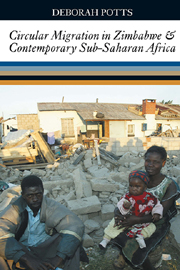Book contents
- Frontmatter
- Contents
- List of Maps, Figures, Tables, Boxes & Photographs
- List of Abbreviations
- Preface
- 1 Introduction
- 2 Regional Paradigms & Approaches to Circular Migration
- 3 Regional Paradigms & Approaches to Circular Migration
- 4 Harare & Zimbabwe
- 5 Migrant Livelihoods & Migration Trajectories in Harare
- 6 Harare Migrants' Rural Links & Assets
- 7 Variations in Migrants' Experience, Perceptions & Options
- 8 Social & CulturalAttachments to Rural Settings & Homes
- 9 Attacking the Urban Poor & Abusing Rural Links Operation Murambatsvina 2005
- 10 Conclusion
- Appendix: Consumer Price Index (all items) for Urban Families 1973–2007
- Bibliography
- Index
7 - Variations in Migrants' Experience, Perceptions & Options
Published online by Cambridge University Press: 05 July 2013
- Frontmatter
- Contents
- List of Maps, Figures, Tables, Boxes & Photographs
- List of Abbreviations
- Preface
- 1 Introduction
- 2 Regional Paradigms & Approaches to Circular Migration
- 3 Regional Paradigms & Approaches to Circular Migration
- 4 Harare & Zimbabwe
- 5 Migrant Livelihoods & Migration Trajectories in Harare
- 6 Harare Migrants' Rural Links & Assets
- 7 Variations in Migrants' Experience, Perceptions & Options
- 8 Social & CulturalAttachments to Rural Settings & Homes
- 9 Attacking the Urban Poor & Abusing Rural Links Operation Murambatsvina 2005
- 10 Conclusion
- Appendix: Consumer Price Index (all items) for Urban Families 1973–2007
- Bibliography
- Index
Summary
What did Harare's migrants think about the city? The analysis so far has built up a picture of their livelihood characteristics and how these have changed over time. These are tangible and usually measurable factors. They are reflected in their plans for their futures which have already been outlined; they are also reflected in people's behaviour, attitudes and perceptions about their lives in the city. These issues are the core of this chapter, which explores migrants' experiences of Harare, and their views about the city. The findings are considered together with the migrants' understandings of how their livelihood options are affected by a variety of intersecting factors, including age, position in the household, housing, employment, rural assets and, in particular, gender.
As explained in Chapter 4, the surveys included qualitative explorations which picked up on unexplained issues from previous surveys, or explored particular current issues. Three of the surveys also included very simple, pre-coded questions asking respondents to compare Harare with their previous place of residence, in terms of the chance of getting a job and of how much money they could earn. In the final survey, which was conducted when the urban economy was in dire straits, this aspect of the research was greatly expanded and the migrants were asked, in addition, to compare standards of living in Harare with their previous place of residence, once various necessary expenditures had been taken into account.
- Type
- Chapter
- Information
- Publisher: Boydell & BrewerPrint publication year: 2010

